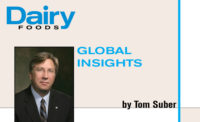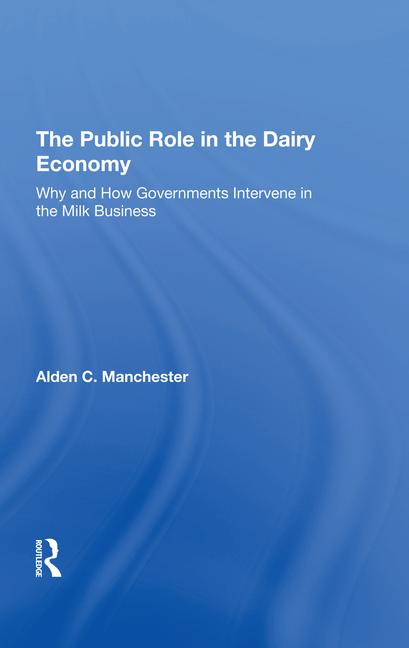U.S. dairy exports create jobs, spur innovation
U.S. dairy export volume averages about 15% of the U.S. milk supply. USDEC believes it can grow that number to 20%. This “Next 5%” is good for all.

Photo for Dairy Foods by Vito Palmisano
The negative repercussions from Canada’s ongoing defiance of its trade obligations are a stark reminder of the critical role exports play in the health and vitality of the U.S. dairy industry.
Over the long term, U.S. milk production is rising faster than domestic demand and will likely continue to do so. Since 2003, nearly half of “new” milk produced in this country has gone to markets beyond our borders.
Dairy exports annually contribute about $15 billion to the U.S. economy, supporting 42,000 U.S. dairy farmers, 100,000 good-paying jobs and countless businesses that provide inputs all along the dairy supply chain. To sustain the benefits that exports bring to this nation, exports need to grow.
What do I mean when I say grow?
The staff at the U.S. Dairy Export Council analyzed U.S. dairy capabilities, global demand expectations and the capacity of competitors to meet the expanding and evolving needs of overseas buyers. Over the last four years, U.S. dairy export volume has averaged the equivalent of about 15% of the U.S. milk supply. We believe we can grow that number to 20% — or as we say at USDEC, “The Next 5%.”
Demand will be there
Population gains and middle class expansion will continue to drive global dairy consumption in emerging markets at a faster pace than domestic dairy industries can match.
Over the next 15 years, Asia’s middle class alone will grow by 2.7 billion people, from about 525 million today to 3.2 billion, which is about 10 times the total current population of the United States.
There is incredible opportunity for U.S. dairy processors and producers with those middle class consumers. USDEC estimates rising consumer demand will increase globally traded milk powder and dry whey volumes by more than 1 million tons by 2021. Demand for other dairy ingredients — milk protein concentrate, lactose and specialized products like lactoferrin and alpha-lactalbumin — will rise by more than 100,000 tons.
On the cheese side, demand for natural cheese at foodservice and retail (as well as pizza and other cheese types) will raise global cheese trade by more than 500,000 tons by 2021.
An ample, rising milk supply and a competitive, evolving product portfolio put the U.S. dairy industry in position to capture significant shares of those additional ingredient and cheese volumes. Backed by rigorous quality and safety standards, U.S. suppliers have made investments in products, people and plants. They have strengthened customer-centric relationships, aiming to cultivate long-term global supply and innovation partnerships.
For USDEC’s part, we plan to focus on three areas to help deliver The Next 5%.There are many facets to each strategy, but briefly:
- Increasing demand includes supporting research into dairy nutrition and communicating positive health links to consumers, governments and aid organizations to buttress consumption. The more we can facilitate the understanding of milk’s benefits and the enjoyment of dairy products here and abroad, the more consumers will gravitate toward dairy. It is particularly important to address younger people to improve the chances that they will continue to utilize milk and dairy products as they age.
- Facilitating sales focuses on making it easier for U.S. suppliers to access overseas markets by collecting and disseminating the technical requirements of exporting — from labeling to testing to certification. But it goes beyond the technical minutiae to an understanding of the subtleties of markets so that U.S. processors can innovate to meet demand and bolster their competitiveness.
- Ensuring market access covers everything, from working to remove non-tariff trade barriers to making sure U.S. dairy concerns are heard during trade negotiations. We continue to fight European Union efforts to restrict the use of common cheese names and Canada’s actions to block U.S. dairy exports. And we work to preserve the trade framework with Mexico that has delivered tremendous U.S. dairy export growth.
We need your help
That is how USDEC expects to help move the needle to The Next 5%. But this is an industrywide effort. We need your continued focus and investment in export markets.
It is important for U.S. suppliers to have a greater physical presence in high-growth-potential regions to gain a better understanding and appreciation for tailoring products to local tastes. That physical presence and responsiveness simultaneously help solidify partnerships, making clear that you want to be a consistent supplier.
We also need your help to educate the American public about the importance of dairy to their lives and to the U.S. economy. We need your help in communicating with our government at every level the significance of exports.
The industry needs to speak with a single voice to improve the chance of being heard by consumers and government.
Together we can create more global demand for what you produce, more open markets, more sales, more income for everyone in the dairy supply chain, more jobs and a stronger industry, which ultimately makes a stronger country.
We are in this together and we will sink or swim together. Let’s swim together to The Next 5%.
Looking for a reprint of this article?
From high-res PDFs to custom plaques, order your copy today!









